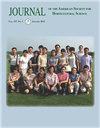Mechanism of Leaf Vein Coloration and Inheritance of Leaf Vein Color, Flower Form, and Floral Symmetry in Gloxinia
IF 1.1
4区 农林科学
Q3 HORTICULTURE
Journal of the American Society for Horticultural Science
Pub Date : 2021-04-20
DOI:10.21273/JASHS05034-20
引用次数: 0
Abstract
Double-flowered gloxinia (Sinningia speciosa) cultivars with foliar variegation might have a greater market appeal as flowering foliage plants. Crosses were made among 16 gloxinia cultivars and their progenies were analyzed to determine the inheritance of leaf vein color, flower form, and floral symmetry. All plants from self-pollinating white-veined cultivars or crosses between white-veined and green-veined cultivars produced white veins. Progeny derived from self-pollinating plants of white-veined cultivars × green-veined cultivars segregated into a ratio of 3 white-veined:1 green-veined. All plants from self-pollinating or cross-pollinating single-flowered cultivars produced single flowers. Progeny of self-pollination or crosses between double-flowered cultivars segregated into a ratio of 3 double flowers:1 single flower. Contingency chi-square tests revealed that leaf vein color and flower form were inherited independently. New gloxinia progenies with homozygous white veins and double flowers were successfully developed from the F2 segregating population. Plants from self-pollinating or cross-pollinating cultivars with actinomorphic flowers produced actinomorphic flowers. A single dominant gene expressed in the homozygous or heterozygous state resulted in the zygomorphic flowers. Independent inheritance was observed between vein color and floral symmetry. Air spaces between the epidermis and the mesophyll cells were observed in the white, but not in the green, leaf vein portions. Net photosynthesis did not differ significantly between the white vein and adjacent green portion of the same leaf.Gloxinia叶脉着色机制及叶脉颜色、花型和花对称性的遗传
具有叶斑的多花gloxinia(Sinningia speciosa)品种可能作为开花观叶植物具有更大的市场吸引力。在16个gloxinia品种之间进行杂交,并对其后代进行分析,以确定叶脉颜色、花型和花对称性的遗传。所有自花授粉的白脉品种或白脉和绿脉品种之间的杂交植物都产生了白脉。从白脉品种×绿脉品种的自花授粉植物中分离出的后代,其比例为3白脉∶1绿脉。所有自花授粉或异花授粉的单花品种的植物都开出单花。双花品种之间的自花授粉或杂交后代以3朵双花∶1朵单花的比例分离。应变卡方检验表明,叶脉颜色和花型是独立遗传的。从F2分离群体中成功地培育出了具有纯合子白脉和双花的新gloxinia后代。具有辐射对称花的自花授粉或异花授粉品种的植物产生辐射对称花。在纯合或杂合状态下表达的单一显性基因导致了左右对称的花。脉色与花对称性之间存在独立遗传。在白色叶脉部分观察到表皮和叶肉细胞之间的空隙,但在绿色叶脉部分没有观察到。同一叶片的白色叶脉和相邻的绿色部分之间的净光合作用没有显著差异。
本文章由计算机程序翻译,如有差异,请以英文原文为准。
求助全文
约1分钟内获得全文
求助全文
来源期刊
CiteScore
3.80
自引率
0.00%
发文量
31
审稿时长
2 months
期刊介绍:
The Journal of the American Society for Horticultural Science publishes papers on the results of original research on horticultural plants and their products or directly related research areas. Its prime function is to communicate mission-oriented, fundamental research to other researchers.
The journal includes detailed reports of original research results on various aspects of horticultural science and directly related subjects such as:
- Biotechnology
- Developmental Physiology
- Environmental Stress Physiology
- Genetics and Breeding
- Photosynthesis, Sources-Sink Physiology
- Postharvest Biology
- Seed Physiology
- Postharvest Biology
- Seed Physiology
- Soil-Plant-Water Relationships
- Statistics

 求助内容:
求助内容: 应助结果提醒方式:
应助结果提醒方式:


